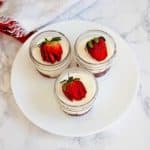Sous Vide Yogurt Fruit Cups
Yogurt is easy to make and beneficial to one's heath. It contains calcium, protein, potassium, phosphorus, magnesium and vitamins B6 and B12.
Servings: 10 Servings
Calories: 115kcal
Ingredients
- 3 ¾ cups (30 ounces) whole milk (See Note 1)
- ¼ cup (2 ounces) plain yogurt with live and active cultures (See Note 2)
- 10 Tablespoons Simply Fruit (See Note 3)
Instructions
- Heat milk to 185° F. Remove from heat; pour through fine wire mesh strainer into 4 or 8-cup measuring cup. Allow to cool to 110° F.
- Add enough water to container such that jars will be completely immersed. Using immersion circulator, heat water to 110° F.
- While milk is cooling, add a tablespoon of fruit to bottom of 10 4-ounce mason jars that have been sterilized.
- When milk reaches 110° F, about 30 minutes, add about ½ cup to ¼ cup of yogurt. Whisk to combine. Pour into remaining milk; whisk to combine.
- Pour milk mixture into mason jars with fruit plus additional mason jar with no fruit (this becomes the starter for your next batch). Screw on lids and bands; carefully lower into 110° F Sous Vide water bath. Heat for 5 hours and up to 24 hours. (See Note 4)
- Remove the yogurt cups from the water bath; allow to cool for 15 minutes. Remove the lids and carefully pour off any whey that has accumulated on the top. Return the lids; refrigerate for up to a week.
- Yield: 10 Sous Vide Yogurt Fruit Cups, plus additional container to use as starter for next batch. (See Note 5 for how to make Greek Yogurt)
Notes
- May also use 2% milk or skim milk.
- Many commercial yogurts are processed in such a way as to kill the live and active cultures. It's imperative that you use yogurt with live and active cultures for the starter. Therefore, be sure to check. Starter bacteria in yogurt includes Lactobacillus bulgaricus and Streptococcus thermophilus. Probiotic bacteria includes Bifidobacterium lactis, Lactobacillus casei, and acidophilus, among others. If you want the probiotic benefits be sure that your starter has probiotic bacteria!
- Use whatever fruit flavor you like. You can also use jam or preserves in place of the Simply Fruit.
- After 5 hours, the yogurt is properly coagulated and ready. However, if you prefer a more tart yogurt, leave it in the water bath for a longer period. The longer it sits in the water bath, the more tart it will become.
- The difference between regular yogurt and Greek yogurt is that Greek yogurt is strained through cheesecloth or a coffee filter to remove most of its liquid. This is what gives Greek yogurt its thicker consistency and stronger flavor compared to regular yogurt. If you'd rather make Sous Vide Greek yogurt, skip the fruit and place the milk with starter in larger sterilized jars. Heat as for regular yogurt. Line fine-mesh strainer with a double layer of cheesecloth or coffee filters and set over large bowl. Transfer completely cooled yogurt to prepared strainer; cover, and refrigerate until desired consistency is achieved. This could take 7 to 8 hours. Discard drained liquid.
Nutrition
Calories: 115kcal | Carbohydrates: 18g | Protein: 3g | Fat: 3g | Saturated Fat: 1g | Cholesterol: 9mg | Sodium: 50mg | Potassium: 150mg | Sugar: 14g | Vitamin A: 150IU | Vitamin C: 1.7mg | Calcium: 119mg | Iron: 0.1mg
